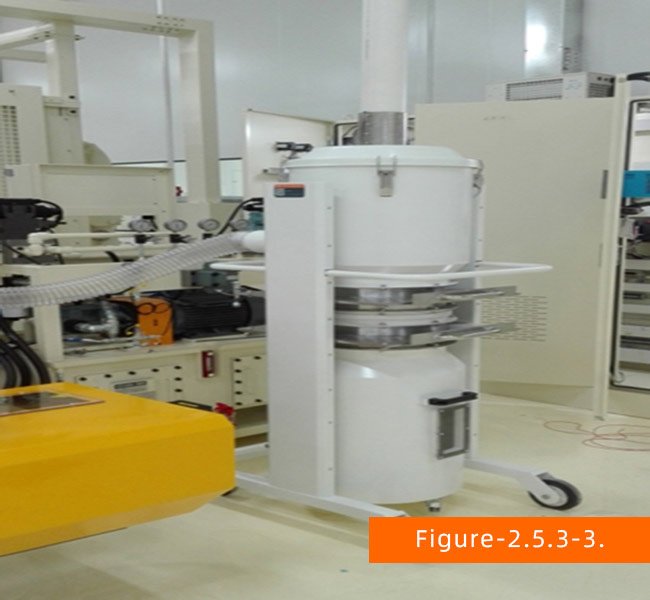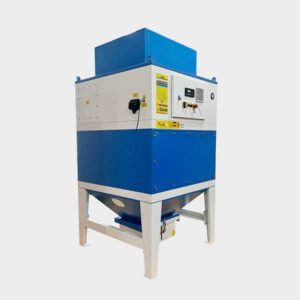Complete Dust Collection Solution
for Lithium Battery Manufacturing
Dust Control Solutions for Lithium-ion Battery Manufacturing
Lithium-ion battery manufacturing has made significant progress in recent years and has become increasingly important in various emerging markets, such as renewable energy and electric or hybrid automobiles. While the process involved in manufacturing batteries can release particles in the air, which can harm workers, machines and product sustainability.From the first step Mixing to the last step packing, Vhich can provide turnkey dust removal solution for lithium-ion manufacturing:

Calendering Process
During calendering process many small powders adhered to the surface of the rollers which needs to be cleaned. The cleanliness of the rollers is necessary for preventing foreign particles from penetrating the substrate material. Roller brush is generally used for cleaning.
In the process, there can be 4 small processes need dust removal:
1.Dust removal for pole piece before calendering: the upper and lower two sides of the pole piece material need to be equipped with a multi-point recycling collection system. Set 2pcs dia50mm air inlet on the cover of the brush (Confluence is about φ100mm), since the amount of dust is limited, VJ or model with higher configuration can solve the dust problem well, and explosion-proof requirements are considered in due course.
Model can be selected:
2.Dust removal for corner cutting: each cutter has a diameter of about φ40, ranging from 2 to 4 (commonly 4 scrapers — 2 for each of the upper and lower rollers). After being put together, the φ75 suction port is enough for dust removal on this position. The suction hood is only equipped on the side of the discharge port, and the diameter of each suction hood is φ75. The cutter dust suction hood is shown in Figure 2.3.3-b, the hood for scrap material suction is under the knife, as shown in Figure 2.5.3-1, and the VMQ system for supporting material receiver is shown in Figure 2.5.3-3, or Figure 2.5.3-4.
Model can be selected:
VMQ receiving machine
3.Roller dust removal: Dust collector with hood is the ideal option for the dust generated by the upper and lower roller scrapers. The diameter of each blade hood depends on the length of the roller, and set multiple suction openings will be gathered into a total dust suction port (commonly φ73mm or φ110mm) The scraper suction hood is shown in Figure 2.3.3-c.
Models can be selected:
Belt-connecting platform: 20-25mm dust extraction pipe cover will be equipped underneath, sharing a main machine with 1 & 3.



Winding Machine
Dust source:
Square battery: During the winding process, the main dust generating points are the powder brush and the main shaft winding area. (that is, the pole piece cutting position)
Cylindrical battery: The main dust production points of the cylindrical battery are the powder (or blowing and suction) box, the welding point of the pole lug, and the winding area of the main shaft (that is, the position where the pole piece is cut off), which produces a certain amount of smoke and cutting chips or particles.
Solution: The dust particle size and smoke volume produced by the winding machine are small, and the diameter of the dust removal pipe supporting the machine is small. It is necessary to support a high negative pressure industrial vacuum cleaner. SC-75 vacuum cleaner / SC-400 and SC-550 vacuum cleaners are optional to ensure debris and fume can be sucked away immediately. The dust-pumping mechanism (powder-pumping box) is directly equipped with a suction tube, which is not visible on the back.
Mixing
The manufacturing process starts with mixing process which involves feeding and discharge of ingredients which generates a serious amount of fine powder dust, which is active material (includes: Lithium cobaltate, lithium manganate, lithium nickelate, lithium iron phosphate and negative material graphite) can have risk of explosion.
Considering the feeding and discharge port is open, so a suction hood is necessary for capture dust from the source, thus a dust collector with big air flow can be applied here.
Model selection:
Slitting Process
In the process of slitting with a slitting machine, a lot of excess powder and waste (leftover material) will be incidentally generated. These powders will be left on the slitting machine, affecting the service life of the equipment and the quality of the battery cells. The source of dust is at the position of the cutter:
Dust removal solution for slitting machine: considering the character of the dust, we will recommend to use a medium pressure type dust collector. Since quantity of suction ports on the different slitting machines is different, then the power of selected dust collector equipped will be different accordingly. SC-T2.2H-T is optional for small slitting machine, and SC-T3.7 and SC-T5.5 are recommended for those worksite with long distance or high wind speed requirements. Anyway, explosion-proof requirements should be considered in due course.
As for leftovers, our SCT and SCG series material receiving machines are the best partners.
Models to be selected:
Laser Die-cutting Process
Laser die-cutting, also called laser pole forming. This process is generally located before the slitting of the square battery. The principle is to cut the corners of the pole piece by laser. During the cutting process, laser fume and waste materials will be generated. Fume and dust must be treated immediately, otherwise the product quality will be affected. Dust removal points include die-cut laser heads, pole piece roller brushes, splice platforms, and air knife at the cutting edge, etc.
Dust removal solution is Specially for the characteristics of the scrap produced by the die-cutting machine (continuous thin strip, segment), it needs to be equipped with a large-capacity collection bag dust collection with explosion proof. User will need to prepare the laser cutting hood for die cutting machine.
Models to be selected:
Lamination
Smoke/Dust source:
Dust is produced during the stacking of pole pieces.
Solution:
The lamination machine is generally equipped with a dust suction port (about φ50mm), and a high negative pressure model is required to ensure that dust and debris are sucked away. If there is no suction port, a side suction cover can be installed near the lamination station, and a suction port of about 50mm is can be connected below the suction cover. The optional models are SC400.SC550,SC850. For those with longer than 5meter belt, SC series models would be the ideal option.
For more details, please contact us directly.
Modular Laser Welding
Source of Welding fumes:
Laser welding generates smoke and fumes which contains hazardous contaminants and should be removed instantly.
Solution:
Welding head is bounded with a ø50 suction nozzle at the side or the welding table is equipped with side suction cover to avoid interference with welding operation. A high negative pressure and explosion-proof type fume extractor would be required to solve the problem. Our SC-1.5 and SCTG series dust collector is an effective solution. Due to high welding power, large sparks and fast splash, the air speed required would be about 23m/s or greater. Also, we will recommend to use a duster.
Tab Welding
Welding Fume Source:
Welding fumes and smoke would generate while performing welding operation on the pole tab.
Solution:
A ø50 suction nozzle and suction hoods are installed above and below each pole tab welding position to wrap the welding head as much as possible. High negative pressure SC, SCG and SCXF series is an efficient solution.
For the cylindrical battery pole tab welding, side suction mouth and extended suction nozzle would be required.
Lamination
Smoke/Dust source:
Dust is produced during the stacking of pole pieces.
Solution:
The lamination machine is generally equipped with a dust suction port (about φ50mm), and a high negative pressure model is required to ensure that dust and debris are sucked away. If there is no suction port, a side suction cover can be installed near the lamination station, and a suction port of about 50mm is can be connected below the suction cover. The optional models are SC400.SC550,SC850. For those with longer than 5meter belt, SC series models would be the ideal option.
For more details, please contact us directly.
Modular Laser Welding
Source of Welding fumes:
Laser welding generates smoke and fumes which contains hazardous contaminants and should be removed instantly.
Solution:
Welding head is bounded with a ø50 suction nozzle at the side or the welding table is equipped with side suction cover to avoid interference with welding operation. A high negative pressure and explosion-proof type fume extractor would be required to solve the problem. Our SC-1.5 and SCTG series dust collector is an effective solution. Due to high welding power, large sparks and fast splash, the air speed required would be about 23m/s or greater. Also, we will recommend to use a duster.

Aluminum Shield Welding
Source of Smoke and fumes:
Welding aluminum alloys produce much more harmful fumes and airborne particles than other materials. As these fumes poses threat to welders, a proper fume extractor should be installed to extract these fumes.
Solution:
Welding head is bounded with a ø50 suction nozzle at the side or the table should be equipped with a side suction cover to avoid interference with welding operation. A high negative pressure and explosion-proof type fume extractor would be required. Our SCCB-1.5 and SCGB series dust collector can efficiently solve the problem. Due to high welding power, large sparks and fast splash, the air speed required would be about 18~25m/s. Also, we will recommend to use a duster.



VHICH Dust Removal Equipment In Li- ion Battery Industry
Want To Find Out More About VHICH ?
Fill in your details and query below, and we will be in touch.
FAQ About Industrial Dust Collector
Most standard collectors filter a high percentage of 2 to 2.5 microns; but I’ve included one that even filters 86% of 1-micron dust particles.
Summary: Small dust collectors for applications up to 1,000 CFM airflow cost between $100 up to $5,000 USD. Pre-fab dust collection systems such as a bin vent or cartridge type collector cost between $10,000 and $80,000 USD.
Depending on the dust characteristics, the correct CFM value should be approximately 100–200 feet per minute of air velocity multiplied by the cross-sectional area of the hood in square feet. Accurate
Including Grizzly, Jet Machinery, Woodstock International, Inc
Industrial dust cleaning equipment, or industrial vacuum systems for dust refer to machinery designed to remove dust and other airborne particles from industrial settings.
Key factors to consider include the type and volume of dust generated, the size and layout of the facility, regulatory requirements, energy efficiency, maintenance needs, and budget constraints.
Contact and Consult with VHICH. This can help you assess your facility’s dust generation rate, airflow requirements, space constraints, and other factors to determine the most suitable size and type of industrial dust cleaning machine.
Yes, VHICH offers customizable options for you to tailor industrial vacuum systems for dust to specific industry requirements, such as size, capacity, filtration efficiency, and integration with existing systems.





